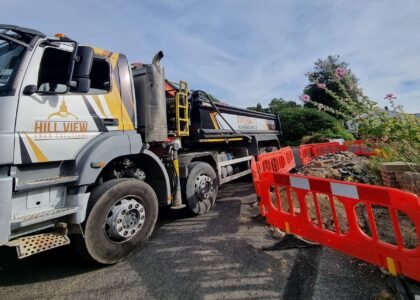Discover how hydraulic breaker attachments are transforming demolition work. This in-depth guide examines their advantages, types, and applications across various industries. Learn how these powerful tools improve efficiency, reduce labour, and cut down costs on job sites. Whether you’re a contractor, builder, or project manager, understanding hydraulic breakers can help you make more informed equipment decisions. Read on to uncover expert insights and make your demolition tasks quicker, safer, and more cost-effective.
In the world of construction and demolition, efficiency is everything. The faster and cleaner a job gets done, the better it is for safety, cost, and timelines. That’s where hydraulic breaker attachments come into play. These powerful tools are revolutionizing the way demolition work is carried out across various industries. From breaking up concrete foundations to busting through rock and asphalt, hydraulic breakers provide unmatched performance and reliability.
What Is a Hydraulic Breaker?
A hydraulic breaker is a powerful percussion hammer fitted to an excavator or backhoe. It utilizes hydraulic power to break down hard materials, such as concrete, rock, or asphalt. Operated via the carrier machine’s hydraulic system, it delivers rapid, high-impact blows that make demolition work faster and more precise.
In essence, it’s like having a high-powered jackhammer attached to a construction vehicle. This integration not only improves force but also allows for better control and reduced manual labour.
Why Hydraulic Breakers Are Essential for Demolition Work
Demolition isn’t just about tearing things down; it’s also about carefully removing them. It’s about doing it safely, efficiently, and with minimal disruption. Hydraulic breakers are tailored for this task. Here’s why:
Speed and Efficiency: Hydraulic breakers significantly reduce the time it takes to demolish large or reinforced structures. Unlike manual methods, which can be slow and labour-intensive, these attachments can complete the job in a fraction of the time.
Reduced Labour Costs: Fewer workers are needed when a hydraulic breaker is used. One operator and one machine can replace several manual labourers, lowering overheads and human risk.
Precision: These tools allow for controlled demolition. That means only the targeted sections are affected, avoiding damage to surrounding structures or utilities.
Versatility: Hydraulic breakers can be used for more than just demolition. They’re effective in trenching, quarry work, road construction, and even mining operations.
Types of Hydraulic Breakers
Not all breakers are created equal. The size and type of hydraulic breaker you need depends on your job site requirements and the carrier machine you’re using. Here are the main types:
Miniature Hydraulic Breakers: These are ideal for lightweight tasks and are often attached to skid steer loaders or mini-excavators. Perfect for residential demolition and indoor work, they’re compact and easy to manoeuvre.
Medium Hydraulic Breakers: Used in urban construction projects, these breakers strike a balance between power and portability. They are often found on mid-size excavators and are ideal for sidewalk removal, foundation breaking, and utility trenching.
Large Hydraulic Breakers: These heavy-duty machines, mounted on large excavators, are designed for high-impact jobs. Think of breaking through thick concrete slabs, boulders, or massive rock formations in mining or large infrastructure projects.
Key Benefits of Using Hydraulic Breaker Attachments
Hydraulic breakers offer numerous operational advantages that make them a top choice for construction and demolition professionals:
Enhanced Productivity: High-impact energy, combined with fast cycling times, enables maximum material breakage in a shorter timeframe. This leads to faster project completion.
Lower Maintenance Costs: Modern hydraulic breakers are designed with fewer moving parts, thereby reducing the need for regular maintenance and repairs. This results in less downtime and greater cost savings.
Fuel Efficiency: Since they complete tasks more efficiently, machines equipped with hydraulic breakers tend to consume less fuel over time. This not only saves money but also reduces environmental impact.
Operator Safety: Reduced manual labour means lower chances of injury. Also, since the operator remains in the cab, they’re shielded from flying debris and excessive noise.
Choosing the Right Hydraulic Breaker
Selecting the right hydraulic breaker for your needs is essential, so ensure you match the breaker to your carrier machine, as an oversized breaker can cause damage while an undersized one may be ineffective; consider the material hardness, since more complex substances like reinforced concrete or granite require more powerful breakers; and check the frequency and energy ratings, opting for high-frequency models for lighter materials and high-energy breakers for dense, stubborn surfaces.
Maintenance Tips for Longevity
Like any equipment, hydraulic breakers require regular care to perform at their best. Here’s how to keep them in top condition:
- Daily inspections: Check for leaks, wear, and loose bolts before every use.
- Proper lubrication: Regularly grease the tool bushings to prevent metal-to-metal contact.
- Correct operation: Never use the breaker as a prying tool, and always operate at the right angle to the surface.
- Use the right tool bits: From moil points to chisel tools, using the correct bit for the job improves efficiency and prevents premature wear.
Applications Beyond Demolition
While demolition is the most common use, hydraulic breakers are versatile enough for several other tasks:
- Trenching: Break through rock to install pipelines and cables.
- Mining: Break large rocks into manageable sizes for further processing.
- Road Construction: Remove asphalt or old pavement quickly and safely.
- Quarrying: Extract raw materials such as stone or limestone efficiently.
Innovations in Hydraulic Breaker Technology
Advancements in technology have improved the performance and durability of modern hydraulic breakers. Some recent developments include:
- Noise and vibration reduction systems: Essential for urban projects to minimise disturbance.
- Auto-greasing systems ensure constant lubrication without requiring manual effort.
- Variable speed controls: Allow for precise adjustments based on the job requirements.
- Advanced hydraulic flow regulation: Improves compatibility with different carrier machines and optimises energy use.
Environmental Considerations
With stricter regulations on construction emissions and waste, hydraulic breakers support eco-friendly operations by:
- Reducing fuel use through faster operations.
- Minimising dust and debris, especially when paired with water suppression systems.
- Enhancing recycling efforts is facilitated by controlled demolition, which allows for easier material sorting and reuse.
Final Thoughts
Hydraulic breaker attachments have revolutionised demolition and construction work. Their unmatched power, precision, and efficiency make them essential for any project requiring material breaking. As the construction industry moves towards smarter, faster, and greener methods, investing in the right hydraulic breaker is a forward-thinking decision.
Whether you’re a contractor demolishing old foundations or a site manager overseeing urban projects, having the right hydraulic breaker on hand can save time, money, and effort—without compromising on quality or safety.





